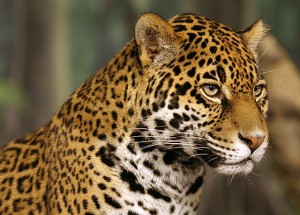- Home
- Accommodation
- Activities
- Area Info
- Maps
- Photo Galleries
- Real Estate
- Travel
Jaguar
Spanish Name: Jaguar / Tigre
Life Span: 12-15 years in wild
Height Weight: Adult males are 50 to 100 kg, and adult females are two-thirds that size.
Found In: In Costa Rica, only in forests of protected reserves.
 In Costa Rica, this big cat is mostly spotted only in forests of protected reserves. Though its sightings have reduced drastically due to depletion in numbers, the endangered jaguar has been spotted recently in Delicias, Malpais, Manzanillo and Cabo Blanco National Park. In the past it has been spotted at the Children’s Eternal Rain Forest, Corcovado National Park, Hoitoy Cerere Biological Reserve, La Selva Biological Station, Monteverde Cloud Forest Reserve, Santa Elana Cloud Forest Reserve, Santa Rosa National Park and Sirena Biological Station. Although a visit to these parks does not ensure a sighting of the jaguar, wildlife enthusiasts in Costa Rica may be lucky enough to spot some of its tracks.
In Costa Rica, this big cat is mostly spotted only in forests of protected reserves. Though its sightings have reduced drastically due to depletion in numbers, the endangered jaguar has been spotted recently in Delicias, Malpais, Manzanillo and Cabo Blanco National Park. In the past it has been spotted at the Children’s Eternal Rain Forest, Corcovado National Park, Hoitoy Cerere Biological Reserve, La Selva Biological Station, Monteverde Cloud Forest Reserve, Santa Elana Cloud Forest Reserve, Santa Rosa National Park and Sirena Biological Station. Although a visit to these parks does not ensure a sighting of the jaguar, wildlife enthusiasts in Costa Rica may be lucky enough to spot some of its tracks.
The jaguar has a yellowish brown coat with a pale stomach and dark spots all over its body. Its tail is short for a large cat less than half the length of its head and body. The animal is wired to grip prey with its head, strong shoulders and forepaws. People come here more to experience their trails than the actual animal sighting.
It used to be a regular sight in many habitats such as mangroves, savannas, wet and dry shrub areas and jungles up to 1000 m. They survive equally well in forests, open lands and near water bodies. Jaguars can often be spotted near water bodies since like most other felines, they love a good swim. However in Costa Rica, this magnificent creature now only graces protected reserves. The jaguar’s numbers are fast reducing owing to its conspicuous tracks, its market demand and notoriety for killing livestock. Other than hunting, habitat destruction has also played a major role in the depletion of their numbers.
Although this big cat rarely attacks humans without provocation and are not known to be much of a threat, they are also known to follow the human scent. The main hazard to the current Costa Rica jaguar population is deforestation for agriculture. These feline’s hunting methods are known to be quite exciting and strategic. Most of the times they will dramatically stalk their prey. They begin the hunting process by stalking their food, followed by ensnaring it and subsequently looking for the perfect chance to fiercely attack its prey.
The jaguar thrives on a varied diet. Though their preferred food is peccary, they are also known to eat monkey, agouti, deer, bird, fish, lizard, turtle, and other animals. Mud tracks have also pointed out that jaguars will feed on dead fish, iguanas, and other dead animals. Unlike some other big cats, jaguars are not wasteful predators, and are even known to completely polish off their prey with the ribs and all. According to the Torteguero park officials, there are about 16 jaguars in the reserve and that they feast on about 1 percent of all the turtle nesting population there. Jaguars are always known for leading solitary lives. However, very oddly, in Tortuguero all the 16 creatures sharing 12 square miles of space eat together, play together and are seen moving together.
The jaguar is a proficient climber and possesses an unusual liking for water. They are often found in and around marshy habitats, mangrove swamps and river banks. The jaguar is a skilled predator and hunts from the ground. Its prey catching techniques are simple yet efficient, seizing its prey by stalking it at close range. Their gestation period is about 3 ½ months, in which the female can give birth to up to four cubs. A juvenile is capable of walking within a few weeks and nurses for about 6 months. A jaguar cub reaches sexual maturity between 2-4 years of age, but the mother stays in close proximity to the youngsters for about a couple of years more till they are fully capable of being on their own.
Jaguar’s are almost on the verge of extinction in Costa Rica. Though several local organizations and animal preservation foundations are championing their cause, they are rapidly being hunted by humans, mainly by farmers and ranchers for protecting their livestock. Though as mentioned above there have been recent sightings of these creatures in some national parks around the country, their population is depleting at an alarming rate.
Additional Resources
Globalpost.com – Into the Costa Rican wild: Jaguars feast on sea turtles
http://travelcostaricanow.com/index.php/Jaguar
Jaguarrescue.com – Rescue program in Playa Chiquita
Jaguar – Costaricajourneys.com jaguar info
Great Stuff

Clandestina Restaurant
My new favorite restaurant, Clandestina is not to be missed by food lovers staying anywhere near to Montezuma. Established in March 2015, Clandestina is the new kid on the block. The Oregon/Tico collaboration is a winner among locals and travelers alike, with artisan craft beers, made onsite by Butterfly Brewing Co. and delicious, exciting […]











